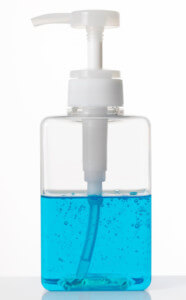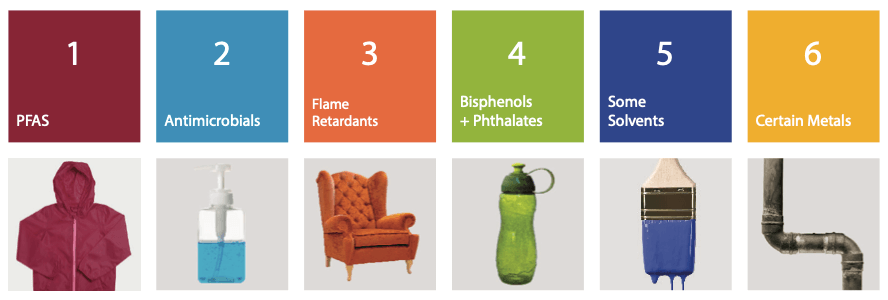March 2020: Why Soap Works Best
In this edition:
- Rainy Weather and Rain Jackets: A Toxic Combination?
- Can We Protect Against Viruses Without Harming our Health?
- It Takes a Global Village: How Denmark Took Action on PFAS
- And the Chemical Industry?
- CALENDAR

The Green Science Policy Institute and I hope you are staying safe and well during these very challenging times. Our team has been working remotely and doing video meetings, sometimes with kids or cats on our laps. An interesting change to share our pets, families, and inside of our homes during our many calls.
We are certainly not the first to advise you to wash your hands. However, we also want to counteract some misleading messages and confirm that plain soap and water are the most safe and effective for cleaning your hands. If that is not possible, alcohol-based hand sanitizers are a second choice. Please click the image above to check out an excellent New York Times article on why soap works. Also, if you cannot find hand sanitizer, you can make it yourself as below.
During these unprecedented days, we cannot press pause on our work for a healthier world. Indeed, chemicals like PFAS and flame retardants can reduce our immune responses and contribute to health conditions that make people more vulnerable to viruses.
Last week I keynoted at the My Green Lab Summit, an inspirational on-line meeting of a community devoted to reducing harmful environmental impacts of labs in research institutions, industry, and hospitals by using less energy, water, and toxics.
You can view my talk from this fun day of presentations, small group discussions, and chat rooms. Could on-line be the future of meetings? No plane flights and much less carbon needed!
Also, in an op-ed published in The Hill last week, our Senior Scientist Tom Bruton, UC Berkeley Environmental Law Clinic Director Claudia Polsky, and Public Employees for Environmental Responsibility Executive Director Tim Whitehouse called on the EPA to regulate PFAS-containing wastes as hazardous. The authors note the agency has yet to do this, despite multi-million-dollar tort verdicts and “a documentary and a Hollywood feature film about the chemicals’ perils.” Our organizations have formally petitioned the EPA to take this critical action.
Before our shelter-in-place order, I enjoyed a ski trip in Jackson Hole, Wyoming, where I hosted four free screenings of Dark Waters. This compelling film, now available for rental, tells the true story of a tenacious attorney (our Institute’s friend and colleague Rob Bilott) who exposed the long time cover-up of the harm of PFAS. For some inspiring entertainment, check out shelter-in-place music from around the world.
With warm wishes for your health and safety,
Arlene and the Green Science Policy team
Rainy Weather and Rain Jackets: A Toxic Combination?
PFAS levels in outdoor jackets and pants may increase when worn in the kind of weather the clothing is meant for, suggests a new study out of the Netherlands.
The scientists tested 13 samples of outdoor clothing marketed as water-repellant before and after exposure to outdoor weather conditions-UV radiation, humidity, and high temperature-for 300 hours. This mirrored the typical wear and lifespan of outdoor clothing.
The team found that exposure to the weather conditions over time resulted in up to a five-fold increase in certain PFAS chemicals. They also found PFAS chemicals in the weathered clothing that were undetected before the experiment. The likely explanation is that PFAS used to make the clothing water-repellant break down into different types of PFAS over time.
This study demonstrates that simply regulating the levels of individual PFAS chemicals in clothing and other products is inadequate. Such policies fail to consider that using a product as intended may multiply the types and levels of PFAS present. To truly protect our health and environment, manufacturers should avoid using the entire class of PFAS.
The good news is that some outdoor clothing brands are already ditching PFAS. We keep track of available PFAS-free clothing, shoes, carpets, and more on our PFAS-free products page.
Can We Protect Against Viruses Without Harming our Health?

By far the best way to protect against viruses, as we continue to hear, is frequent and thorough handwashing with soap and water for at least 20 seconds. If this is not possible, the next best is a thorough scrubbing with alcohol-based hand sanitizer.
Contrary to some advice on the web, hand sanitizer doesn’t have to be organic and you can make your own if it’s not available. Be sure the alcohol content of the mixture you make is at least 60% to kill viruses and better not much more than 70% to avoid drying your skin. Note that hand sanitizer does not usually contain antimicrobials of concern.
How to Make a 60 – 70% Alcohol Hand Sanitizer
* 2 parts 99% isopropyl rubbing alcohol (not 70% rubbing alcohol)
* 1 part aloe vera gel
* 1-2 drops essential oil (optional)
* Mix ingredients above.
* Add to clean bottle.
To learn more, check out the Women’s Voices for the Earth blog and webinar released this week, San Francisco’s Environment Department SF Approved list of disinfectants, and our Six Classes video on antimicrobials.
It Takes a Global Village: How Denmark Took Action on PFAS
At this time when global cooperation is paramount, we reflect on how Danish scientists, with support of scientists worldwide, have led the way to limiting the use of the chemical class of PFAS.
In 2013, scientists at the Technical University of Denmark, and the Universities of Copenhagen and Southern Denmark organized a pivotal PFAS conference leading to the Helsingør Statement on Poly- and Perfluorinated Alkyl Substances. This scientific consensus statement documented the harm of PFAS; questioned the transition from the use of long-chain PFAS to short-chain and other fluorinated alternatives; and called for an end to non-essential uses of all PFAS.
Our Institute collaborated with the authors of the Helsingør Statement to write a second consensus statement, the Madrid Statement on Poly- and Perfluoroalkyl Substances, signed by more than 200 scientists and published in 2015. The statement called on the international community to cooperate in limiting the production and use of PFAS and in developing safer nonfluorinated alternatives. Danish scientists and NGOs used these consensus statements-and the attention they received in the media-to initiate action in reducing the use of PFAS in Denmark.
In 2015 Coop Denmark, one of Denmark’s largest retailers, phased out PFAS in food packaging for all its private label products. Coop had to remove all microwave popcorn from its shelves as the packaging contained PFAS. Six months later a PFAS-free popcorn bag was developed. In 2016 Coop also removed PFAS from outdoor gear textiles, like ski suits and rainwear. In 2019 Coop stopped selling cosmetics that contain PFAS.
Coop joined Danish scientists and NGOs in pushing for national legislation to ban PFAS in food-contact materials. In 2019, in a historic move, the Danish government announced it would ban PFAS in paper and cardboard used in food-contact materials by July 2020. Denmark is the first country to do so, and we look forward to seeing more countries follow its lead.
Coop has attributed the support from the scientific community and the Helsinger and Madrid statements as the bases for these landmark changes in Denmark-an excellent example of science impacting policy!
And the Chemical Industry?
The chemical industry is taking advantage of the current crisis to request the relaxation of environmental regulation so more toxic pollutants can be released with the potential to harm our population and environment. Additionally, they are promoting their antimicrobial products as “Coronavirus Fighting Products” irrespective of the potential for harm from some of the ingredients.
A productive way to pass some time and learn more about chemicals of concern would be to watch our seven short informative videos on the Six Classes of harmful chemicals at SixClasses.org. Tackling toxics by class rather than one-by-one is more necessary than ever.
New research led by our colleague at ETH Zürich found that over 350,000 chemicals and mixtures of chemicals have been registered on the global market–up to three times as many as previously known. And the identities of over 120,000 of those chemicals are hidden from the public by confidential business information claims and vague reporting.

CALENDAR
April 4, 2020: Global Health and Innovation Conference, New Haven, CT
Tom Bruton will present on the Six Classes at Unite for Sight’s 17th annual Global Health & Innovation Conference.
- Where: Online
October 28, 2020: CWEA PFAS Summit, Reno, Nevada
Arlene Blum will keynote the PFAS Summit at California Water Environment Association (CWEA) Annual Conference. Her talk is entitled: “PFAS: What It is, What It Comes From, Where It’s Found and Its Dangers”
- When: 10:00am
- Where: Reno-Sparks Convention Center, Reno, NV
Receive Updates By Email
Subscribe to our monthly newsletter and get these updates delivered right to your inbox!

